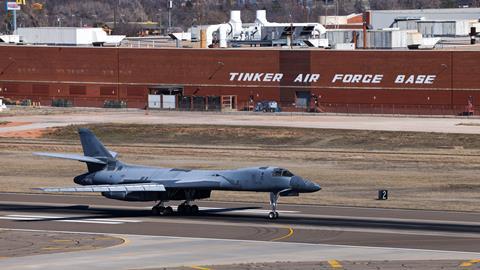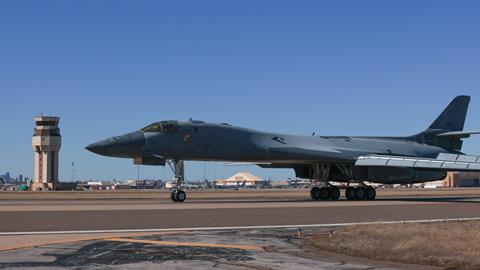The US Air Force (USAF) has restored a previously mothballed Boeing B-1B Lancer heavy bomber to flying condition and is preparing the jet for a return to full operational service.
Given the moniker “Lancelot”, the four-engined jet recently arrived at Tinker AFB in Oklahoma for a full overhaul and mission system modernisations, after nearly three years in storage.
The USAF on 4 April said the B-1B arrived at Tinker after being restored to airworthiness by technicians at the Pentagon’s aircraft “boneyard” at Davis-Monthan AFB near Tucson, Arizona.
The bomber was flown to the Oklahoma MRO facility in February, a move that was not previously announced, apparently for security reasons. Now the air force says the nearly “regenerated” B-1B is “set to rejoin the fleet”.
Lancelot was one of 17 B-1Bs retired to the boneyard in 2021, under a USAF plan to save money by reducing its fleet of the Cold War-era supersonic bombers to the current level of 45 aircraft. The associated funds were intended to support development of the Northrop Grumman B-21 next-generation stealth bomber.

Four of the decommissioned B-1Bs from that group were preserved in so-called “Type 2000” storage, a condition that allows the aircraft to be used for salvage parts or recalled to active service.
The air force moved to regenerate Lancelot after another B-1B suffered what the service describes as a “catastrophic engine failure” during routine maintenance in 2022. The subsequent fire damaged the bomber to the point that repairing it was deemed impractical.

Technicians at Davis-Monthan restored Lancelot to airworthiness after two years and 11 months in boneyard storage, allowing the jet to be ferried to Tinker AFB for full restoration.
“The aircraft will also receive upgrades missed during its retirement so that its capabilities match other aircraft in the fleet,” the air force says.
Dyess AFB, home of the USAF’s 7th Bomb Wing, said in March that it is expecting the restored B-1B to be delivered for frontline service “later this year”.
The Texas air base is one of just two facilities in the world permanently hosting B-1Bs, with the other being Ellsworth AFB in South Dakota. The USAF is the sole operator of the Lancer, which the service uses for ultra-long endurance, non-nuclear strike missions.

In February, a flight of B-1Bs from Dyess flew a multi-day, non-stop sortie to strike targets in Syria. The USAF lists the Lancer’s range only as “intercontinental”.
Each B-1B carries a payload of 34,020kg (75,000lb) – equivalent to 84 of the USAF’s Mk82 226kg general purpose bombs or 15 GBU-38 Joint Direct Attack Munition guided bombs.
More regenerated B-1Bs could join Lancelot in returning to service.
The USAF’s other Lancer operator – the 28th Bomb Wing at Ellsworth – also lost an aircraft in January, when the bomber crashed during a night landing in bad weather. All four crew safely ejected in that incident.



















































